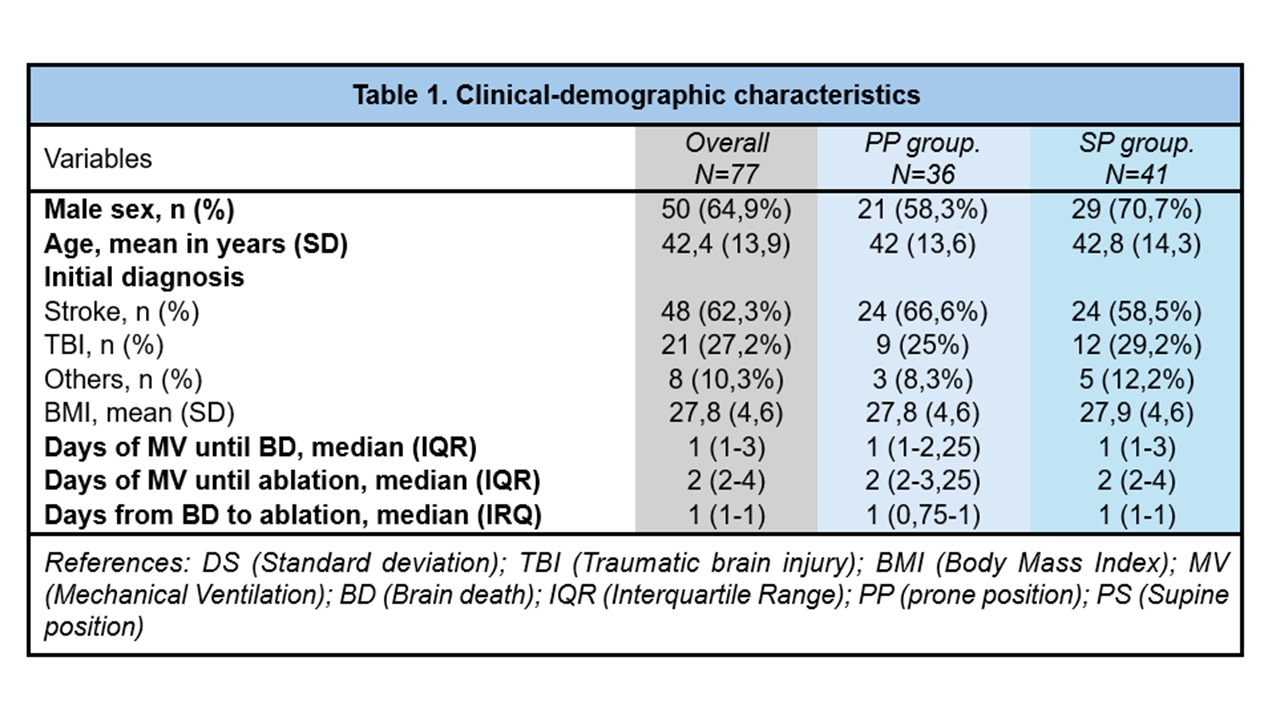Prone positioning in potential organ donors. Preliminary results. PRODON-AR multicenter study
Pablo Centeno1,2,3, Daniel Rodriguez1,3, Hugo Vitale4,10, Ernesto Montiel3,5, Belen Murgia3,6, Eva Rodriguez3,6, Carlos Eckard7,11, Eugenia Alvarez7,11, Emiliano Alfonso8,12, Jorge Velazquez9,13.
1Intensive care unit, Hospital de Alta Complejidad del Bicentenario Esteban Echeverria, Monte Grande, Argentina; 2INCUCAI, Buenos Aires, Argentina; 3Sociedad Argentina de Terapia Intensiva, Buenos Aires, Argentina; 4Intensive care unit, Hospital Central de Mendoza, Mendoza, Argentina; 5Intensive care unit, Hospital Cuenca Alta de Cañuelas, Cañuelas, Argentina; 6Intensive care unit, Hospital Simplemente Evita de Gonzalez Catán, Gonzalez Catán, Argentina; 7Intensive care unit, Hospital Padilla de Tucumán, Tucumán, Argentina; 8Intensive care unit , Hospital San Martín de Corrientes, Corrientes, Argentina; 9Intensive care unit, Hospital San Martín de Paraná, Paraná, Argentina; 10INCAIMEN, Mendoza, Argentina; 11CUCAITUC, Tucumán, Argentina; 12CUCAICOR, Corrientes, Argentina; 13CUCAIER, Entre Ríos, Argentina
Introduction: Maintaining lungs suitable for transplantation poses a challenge due to functional deterioration caused by the sympathetic cascade initiated upon the onset of brain death (BD), compounded by ventilatory support and absence of respiratory muscle activity, leading to atelectasis and consequent gas exchange abnormalities resulting in homeostatic disturbance. Prone positioning increases pulmonary parenchyma availability by enhancing ventilation in potentially recruitable zones and improving V/Q ratio. This study proposes the use of prone positioning (PP) as a preventive strategy for pulmonary deterioration in organ donors (OD). The objective of this study is to analyze if PP application after BD certification increases the number of lungs suitable for transplantation. Additionally, it investigates if PP increases the availability of other organs suitable for transplantation and its impact on hemodynamic function.
Method: The PRO-DONAR study is a randomized controlled trial (RCT), prospective, longitudinal, multicenter, parallel-group study. It is conducted from June 1, 2023, until the target sample size of 250 OD is reached. Eleven ICUs in Argentina participate. Subjects with BD certification meeting multi-organ donor criteria and no opposition to donation are included.
Results: This preliminary analysis includes 77 OD, 36 in the prone group and 41 in the supine group. Table 1 shows clinical-demographic characteristics. Regarding the primary objective, in this preliminary analysis, both groups had 1 potential lung donor more compared to the initial condition (see Figure 1). There were no differences in noradrenaline requirement (median of 0.08 mcg/kg/min initially in both groups and 0.05 pre-ablation mcg/kg/min). Regarding effective donation of other organs, the prone group had a higher percentage of kidney, pancreas, liver, heart, and lung donations. In a sub-analysis including those with PaO2/FiO2 less than 300, it was observed that in the prone group, 6 OD improved their condition to become lung donors, while in the supine group, none improved their condition.
Conclusion: A complete sample size is necessary to draw valid conclusions.


